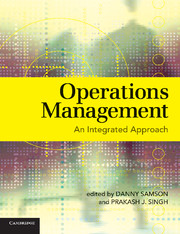Book contents
- Frontmatter
- Contents
- List of Contributors
- Preface
- Acknowledgements
- Part I Operations within Organisations – Building Blocks
- Part II Approaches to Understanding OM
- Part III Moving Forward with OM – Creating Competitive Advantage
- Part IV Challenges and Opportunities in Operations
- Part V Case Studies
- 1 Innovation in the Biotechnology Sector: The Case of IDT Australia
- 2 New Zealand King Salmon: Value-Chain Innovation
- 3 Pilila Clothing Company Goes Lean
- 4 From Singapore to the World: Port Management in Singapore
- 5 Striving for Operations Excellence within Queensland Rail Supply Division
- 6 Should I Stay or Should I Go? Shiraishi Garments Company
- 7 Towards a Green Supply Chain: Toyota Australia
- 8 Process Analyses and Improvement at Bartter Enterprises
- 9 Operations Challenges at Firth Industries Limited, Wellington Division
- 10 Ford Motor Company: Moving Forward in Australia
- 11 Technology Transfer at Hero Honda
- 12 Why Is the Patient Resident Time so Long?: The Case of St Martin's and Charity Private Hospital
- Index
6 - Should I Stay or Should I Go? Shiraishi Garments Company
Published online by Cambridge University Press: 05 June 2012
- Frontmatter
- Contents
- List of Contributors
- Preface
- Acknowledgements
- Part I Operations within Organisations – Building Blocks
- Part II Approaches to Understanding OM
- Part III Moving Forward with OM – Creating Competitive Advantage
- Part IV Challenges and Opportunities in Operations
- Part V Case Studies
- 1 Innovation in the Biotechnology Sector: The Case of IDT Australia
- 2 New Zealand King Salmon: Value-Chain Innovation
- 3 Pilila Clothing Company Goes Lean
- 4 From Singapore to the World: Port Management in Singapore
- 5 Striving for Operations Excellence within Queensland Rail Supply Division
- 6 Should I Stay or Should I Go? Shiraishi Garments Company
- 7 Towards a Green Supply Chain: Toyota Australia
- 8 Process Analyses and Improvement at Bartter Enterprises
- 9 Operations Challenges at Firth Industries Limited, Wellington Division
- 10 Ford Motor Company: Moving Forward in Australia
- 11 Technology Transfer at Hero Honda
- 12 Why Is the Patient Resident Time so Long?: The Case of St Martin's and Charity Private Hospital
- Index
Summary
Introduction
Takashi Shiraishi gazed out his office window watching reflections of the afternoon sun on Tokyo Bay. It was 9 February 2005. Since early last year, Shiraishi Garments Co. (SGC) had begun outsourcing whole production to China to increase profit margins. As President, Takashi saw the immediate benefit of outsourcing to his bottom line. But he also saw moral issues with buying low-cost Chinese goods at the expense of worker health and safety. It concerned him for personal and business reasons. As a consumer goods company dealing in clothing and apparel, SGC needed to maintain a positive reputation: market success depended on its brand.
Japanese companies had been wrestling with public trust for several years, ever since the Snow Brand milk poisoning episode in 2000, in which over 13,000 people became seriously ill. Usage of cheap overseas labour was reported widely as the reason Japanese companies were moving operations out of Japan and increasing domestic unemployment. Many Japanese companies outsourcing businesses overseas were taking steps to demonstrate concern for all employees and a strong commitment to corporate citizenship. SGC worked hard to improve labour conditions in its Chinese supply chain. For instance, when Takashi found local suppliers were reluctant to make the initial financial investments for first aid training in factories, SGC paid for the initial sessions. Soon thereafter, Chinese partners saw less time lost due to injuries and began to embrace first aid training.
- Type
- Chapter
- Information
- Operations ManagementAn Integrated Approach, pp. 473 - 482Publisher: Cambridge University PressPrint publication year: 2008



